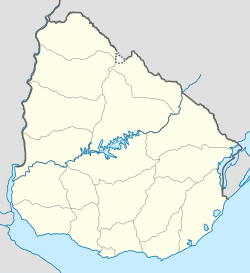Montevideo
From Wikipedia, the free encyclopedia
For other uses, see Montevideo (disambiguation).
| Montevideo Former colonial name: City of San Felipe y Santiago de Montevideo |
|||
|---|---|---|---|
| — Capital city — | |||
| From left to right: Plaza Independencia, Solís theatre, World Trade Center Montevideo, Rambla Sur. | |||
|
|||
| Nickname(s): La Muy Fiel Y Reconquistadora The Very Faithful And Reconquerer |
|||
| Motto: Con libertad ni ofendo ni temo With liberty I offend not, I fear not. |
|||
| Coordinates: 34°53′1″S 56°10′55″WCoordinates: 34°53′1″S 56°10′55″W | |||
| Country | |||
| Department | Montevideo Department | ||
| Founded | 1724 | ||
| Founder | Bruno Mauricio de Zabala | ||
| Government | |||
| • Intendant | Ana Olivera | ||
| Area | |||
| • Capital city | 209 km2 (81 sq mi) | ||
| • Urban | 429 km2 (166 sq mi) | ||
| • Metro | 1,350 km2 (520 sq mi) | ||
| Elevation | 43 m (141 ft) | ||
| Population (2010 est.[1]) | |||
| • Capital city | 1,336,878 (1st) | ||
| • Urban | 1,700,000 | ||
| • Metro | 1,800,000 | ||
| Demonym | montevideano (m) montevideana (f) |
||
| Time zone | UYT (UTC−3) | ||
| • Summer (DST) | UYST (UTC−2) | ||
| Postal code | 11#00 & 12#00 | ||
| Area code(s) | +598 2 (+7 digits) | ||
| HDI (2005) | 0.884 – high 1st Latin America [2][3][4][5][6][7] |
||
Described as a "vibrant, eclectic place with a rich cultural life", it is the hub of commerce and higher education in Uruguay: its first university, the Universidad de la República, was founded in 1849.[2][4][9] The architecture of Montevideo reflects its history, ranging from colonial to Art Deco, and influenced by Spanish, Portuguese, Italian, French and British immigrants.[2][3][10] (by wikipedia)




No comments:
Post a Comment